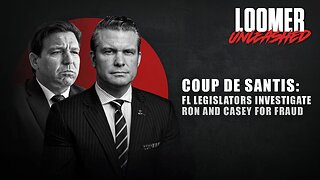Premium Only Content

5 Ways NASA Uses Solar Power
From studying life on Earth to powering spacecraft across the solar system, NASA uses solar power to explore near and far.
In September 2024, the Heliophysics Big Year theme is Environment and Sustainability. The Heliophysics Big Year is a global celebration of the Sun’s influence on Earth and the entire solar system. From Oct. 14, 2023, to Dec. 24, 2024, the Heliophysics Big Year celebrates under a theme, sharing opportunities to participate in many solar science events and activities. During the Heliophysics Big Year, participation isn’t limited to science – NASA invites everyone to celebrate the Sun with as many Sun-related activities as they can.
To learn more about NASA’s history with solar power, visit: https://science.nasa.gov/sun/how-nasa...
Music credit: "Neutral Motion" by Eric Chevalier [SACEM] from Universal Production Music
Credit: NASA's Goddard Space Flight Center
Producer: Lacey Young (MORI Associates)
Editor: Lacey Young (MORI Associates)
Writer: Lacey Young (MORI Associates), Mara Johnson-Groh (Rothe Enterprises, Inc.), Miles Hatfield (MORI Associates)
This video can be freely shared and downloaded at https://svs.gsfc.nasa.gov/14688. While the video in its entirety can be shared without permission, the music and some individual imagery may have been obtained through permission and may not be excised or remixed in other products. Specific details on such imagery may be found here: https://svs.gsfc.nasa.gov/14688. For more information on NASA’s media guidelines, visit https://nasa.gov/multimedia/guidelines.
Transcript
0:00
For decades, NASA has used solar power to explore near and far –
0:05
from studying life on Earth to powering spacecraft across the solar system.
0:10
Here are five ways NASA has harnessed the power of the Sun.
0:14
Parker Solar Probe flies closer to the Sun than any spacecraft before.
Parker Solar Probe
0:19
Its solar arrays create electricity to power and move
0:22
the spacecraft's heat shield, protecting it from the Sun's intense heat.
Mars Helicopter
0:27
On the surface of the Red Planet,
0:28
the Sun powered the rotors of the Ingenuity Mars Helicopter.
0:32
These were the first-ever powered, controlled flights on another planet,
0:35
and will pave the way for future flights in our solar system.
0:39
Closer to home, six Roll-Out Solar Arrays on the International Space Station
Solar Arrays
0:44
make life in low Earth orbit possible
0:46
by powering things like scientific payloads and life support systems.
Rollout
0:51
Also in low Earth orbit,
0:52
the PACE satellite uses solar power to run its scientific instruments,
0:56
including the Ocean Color Instrument, which studies ocean health.
1:02
On the ground,
1:03
solar panels propelled GROVER across the Greenland Ice Sheet
1:06
to study how it gains and loses ice over time.
1:09
The rover's solar panels were positioned to collect
1:12
light directly from the Sun, as well as rays reflected off the ice.
1:16
These are just a few of the ways solar energy has been and continues
1:20
to be a vital force for NASA's explorations of our world and beyond.
-
 37:25
37:25
Uncommon Sense In Current Times
17 hours ago $1.10 earnedFaith-Based Films Are Rising—And Hollywood Can’t Ignore It | Greg Rabidoux
34.9K3 -
 11:14
11:14
unclemattscookerylessons
1 day ago $0.53 earnedRoast beef and yorkshire pudding
22.7K10 -
 2:46:10
2:46:10
TimcastIRL
12 hours agoTim Pool & Crew CRASH White House Press Briefing And Liberal Media IS PISSED | Timcast IRL
284K179 -
 2:49:19
2:49:19
Laura Loomer
12 hours agoEP116: COUP DE SANTIS: FL Legislators Investigate Ron And Casey For Fraud
105K71 -
 8:00:00
8:00:00
SpartakusLIVE
18 hours ago$50,000 Tourney w/ ZLANER & Oak! || MORE WZ to follow
54.8K5 -
 1:51:14
1:51:14
FreshandFit
2 days agoUniversity Of South Carolina Speech
136K54 -
 2:09:39
2:09:39
RiftTV/Slightly Offensive
15 hours ago $15.32 earnedJordan Peterson EMBARRASSES Himself On Rogan with PITIFUL Rant on “Extremism” | Slightly Offensive
79.2K78 -
 14:38
14:38
Producer Michael
15 hours agoWE TRIED TO SELL OUR CARS AT CARMAX!
85.4K5 -
 5:36:05
5:36:05
a12cat34dog
14 hours agoI'VE NEVER PLAYED THIS GAME :: The Elder Scrolls IV: Oblivion Remastered :: FIRST-TIME PLAYING {18+}
53.1K9 -
 2:17:47
2:17:47
AlaskanBallistics
21 hours ago $19.65 earnedI Love this Gun Podcast #28
82.6K14